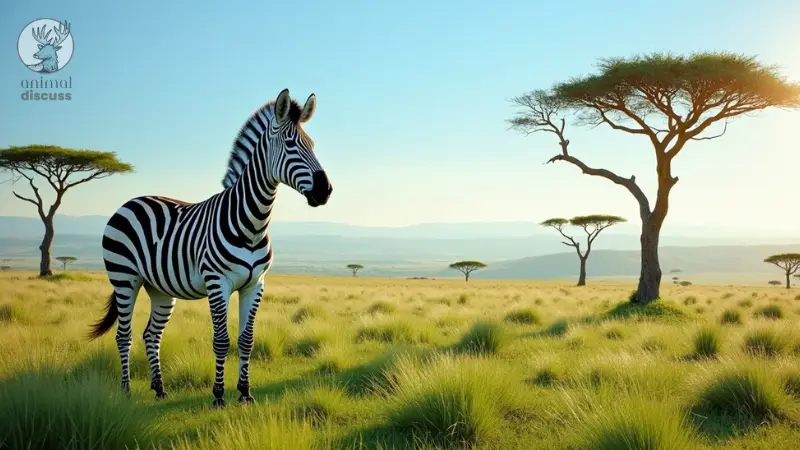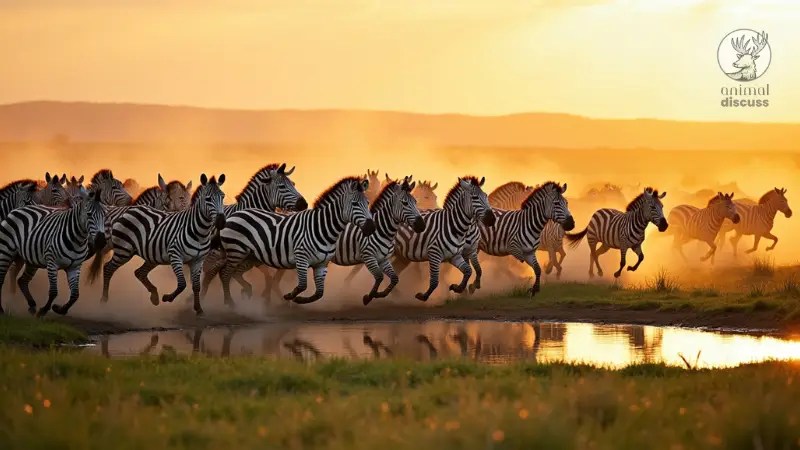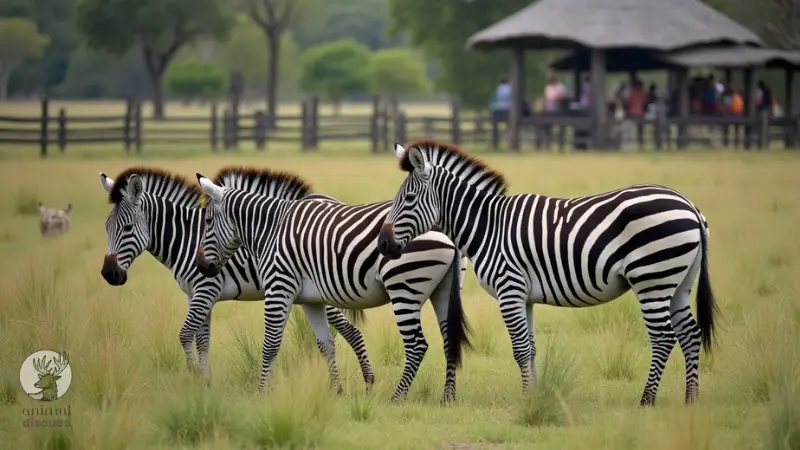Zebras are known for their striking black-and-white stripes, but where exactly do these unique animals live?
In this article, we’ll dive deep into:
- Where zebras live and thrive
- How species adapt to their habitats
- The role of water and migration
- Habitat threats and conservation
- Importance of wildlife reserves
Let’s start by covering the key areas where zebras can be found and the environmental factors that affect their survival.
Curious about zebra biology and lifestyle? Visit our comprehensive zebra overview to discover more.
What Are the Common Habitats of Zebras?
Zebras primarily live in African savannas, grasslands, and open woodlands.

These wide, open areas provide zebras with the necessary resources like grass and water while allowing them to spot predators from a distance.
Types of Habitats
Zebras are not confined to just one type of habitat. They thrive in a range of environments:
- Grasslands: These areas are rich in the grasses that form the bulk of the zebra’s diet.
- Savannas: This is the most common habitat for zebras, offering both grassy areas for grazing and trees for occasional shade.
- Woodlands: Although zebras prefer open spaces, some species, like the Mountain zebra, can also survive in more rugged terrains.
Zebras are often found near water sources, especially in regions with prolonged dry seasons.
Access to water is critical, and zebras will travel long distances to find it during droughts.
What Is the Geographic Range of Zebras?
Zebras are native to Africa and are mainly found in Eastern and Southern Africa. They can be seen in a range of countries, including:
- Kenya
- Tanzania
- Botswana
- Namibia
The geographic range varies slightly between zebra species.
For instance, Plains zebras are widespread across savannas, whereas Grevy’s zebras are more restricted to northern Kenya and southern Ethiopia.
Here’s a breakdown of zebra species and their specific habitats:
| Zebra Species | Habitat Type | Geographic Range |
| Plains Zebra | Grasslands, savannas | Eastern and Southern Africa |
| Grevy’s Zebra | Semi-arid regions | Northern Kenya, Southern Ethiopia |
| Mountain Zebra | Rocky, mountainous areas | Namibia, South Africa |
How Do Different Zebra Species Adapt to Their Habitats?
Each zebra species has developed specific adaptations to thrive in their particular environments.
Plains Zebra
Plains zebras, the most common species, are highly adaptable and can survive in a variety of environments.

They can tolerate areas with less water due to their ability to travel long distances in search of food and hydration.
Their social structure (traveling in herds) helps protect them from predators in these open habitats.
Mountain Zebra
The Mountain zebra is uniquely adapted to live in rocky, mountainous regions.
Their hooves are harder and more robust, allowing them to navigate rugged terrains.
These zebras tend to stay at higher altitudes, where vegetation is sparser, but they rely on the ability to find food in more challenging landscapes.
Grevy’s Zebra
Grevy’s zebras live in semi-arid environments, where water is scarce.
They have adapted by being able to go longer periods without drinking and can survive on limited resources.
Unlike other zebras, Grevy’s zebras often graze near permanent water sources, as their habitats are more prone to droughts.
What Vegetation and Food Sources Do Zebras Rely On?
Zebras are herbivores, and their diet mainly consists of different types of grasses.
However, their specific food preferences can vary depending on the region and season.
Grasses and Plants
Zebras prefer short to medium-length grasses, which are abundant in savannas and grasslands. During the rainy season, they graze on the fresh, green shoots that grow abundantly.
In the dry season, when fresh grass is scarce, zebras can also consume shrubs and leaves from nearby vegetation.
Water Dependency
While zebras primarily graze on grasses, their access to water plays a critical role in their habitat choice.
During dry seasons, zebras migrate toward waterholes and rivers, sometimes traveling vast distances to find drinking water.
How Do Environmental Factors Impact Zebra Habitats?
Zebra habitats are increasingly under threat due to environmental and human factors.
Climate Change and Drought
The frequency of droughts in Africa is on the rise due to climate change.
This has a direct impact on zebra populations, as their water and food sources become scarcer.
Without access to sufficient grass and water, zebras must migrate more frequently, which can lead to territorial conflicts with other herbivores.
Human Encroachment
Human activities, such as agriculture and urban expansion, have also led to habitat loss for zebras.
Large areas of natural habitat are being converted into farmland, reducing the space available for zebras to graze and migrate freely.
How Do Zebras Use Their Habitat for Survival?
Zebras are well-equipped to utilize their habitat to ensure their survival. One of the most notable ways is through their migratory behavior.
Migration and Group Behavior
Zebras migrate in large herds to find fresh grass and water, especially during the dry season. This migration not only ensures they have enough to eat, but also helps them evade predators.

Traveling in large numbers allows them to use the safety-in-numbers strategy, reducing the risk of attacks by lions or hyenas.
Terrain Utilization
Zebras use their environment to evade predators.
For example, in areas with tall grasses or uneven terrain, zebras can use their camouflage (their stripes help them blend in) and the landscape to avoid detection.
Additionally, zebras often travel to waterholes, which are essential not only for drinking but also for socializing and keeping a close eye on potential threats.
How Do National Parks and Reserves Contribute to Zebra Habitat Preservation?
Due to habitat loss and poaching, many zebras now rely on national parks and wildlife reserves for survival.
Some of the most well-known reserves include the Serengeti in Tanzania and the Maasai Mara in Kenya, where large populations of plains zebras thrive.
Protected Areas
These protected areas are crucial for zebra conservation, as they provide a safe space for zebras to graze, migrate, and breed without the threat of human interference.

Many of these parks also have wildlife corridors, which are essential for allowing zebras to migrate during different seasons without leaving the safety of the reserve.
Conservation Efforts
Conservation organizations are working to expand protected areas and restore habitats that have been degraded by human activities.
These efforts are key to ensuring that zebras and other wildlife can continue to thrive in their natural environments.
What Are the Threats to Zebra Habitats?
Zebras face numerous threats, most of which are directly linked to human activities and environmental changes.
Habitat Loss
As mentioned earlier, human encroachment is one of the leading causes of zebra habitat loss.
As cities and farms expand, the natural landscapes zebras depend on for grazing and migration are shrinking.
Climate Change
The impact of climate change is becoming increasingly severe, with prolonged droughts and irregular rainfall patterns.
These conditions make it harder for zebras to find the necessary resources to survive.
Poaching and Hunting
Although less common than habitat loss, poaching still poses a threat to zebras, particularly Grevy’s zebras.
These animals are sometimes hunted for their skins or for bushmeat, which further reduces their population numbers.
What Conservation Measures Are in Place to Protect Zebra Habitats?
Conservation efforts have been ramped up to protect zebra habitats and ensure the survival of these majestic animals.
Wildlife Reserves and Parks
Governments and international organizations are working to create and maintain wildlife reserves that are safe havens for zebras.
These parks are carefully monitored, and anti-poaching measures are in place to protect zebras from illegal hunting.
Habitat Restoration
Habitat restoration programs are also in place to rehabilitate areas that have been damaged by human activity.
These programs involve replanting grasses, controlling invasive species, and restoring natural water sources.
Public Awareness and Education
Conservation groups are raising awareness about the importance of protecting zebra habitats and ensuring that local communities understand the role they play in preserving biodiversity.
Eco-tourism also provides a sustainable way to support conservation while generating income for local economies.
Conclusion
Zebra habitats are diverse, ranging from savannas to mountainous regions. Their ability to adapt to different environments, combined with migration and water availability, plays a crucial role in their survival.
However, habitat loss and human activities pose significant threats, making conservation efforts more important than ever. National parks and reserves remain vital for protecting these majestic animals.
Understanding the intricacies of zebra habitats not only highlights their adaptability but also emphasizes the need for ongoing efforts to ensure their future in the wild.
References:
- National Geographic. Zebra animal facts.
- IUCN. Red List: Equus zebra, Equus grevyi, Equus quagga.
- WWF. Zebra – Species and Conservation.
- African Wildlife Foundation. Zebra Information and Habitat.

